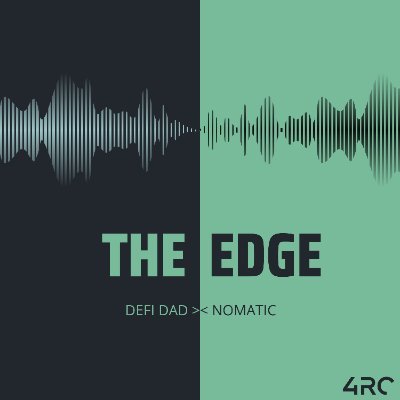In this episode of The Edge Podcast which took place on March 27, 2024, DeFi Dad, Nomatic, and Austin discuss Omni Network, fragmentation of layer-2 liquidity, and more. Read our notes below to learn more.
Background
- DeFi Dad (Host) – Host of Edge Podcast
- Nomatic (Host) – Co-Host of Edge Podcast
- Austin King (Guest) – Founder of Omni Network
- Omni Network – a blockchain built to unite all roll ups.
Austin’s background
- Austin says that he got introduced to crypto during his Harvard days, leading him to delve into mining Ethereum and programming solidity contracts.
- He says that he was inspired by the potential of blockchain beyond finance, Austin committed to building a crypto company during his senior year at Harvard.
- Austin says that his first company before Omni was Strata, which developed the Interledger Network, focusing on interoperability for layer-2 solutions. The Interledger Network achieved high-performance levels, processing over 4,000 payments per second and exceeding 10 billion transactions before being sold to Ripple.
- He adds that after selling Strata to Ripple, the speaker left to build a DeFi protocol that quickly reached a cap of $50 million within two days of launch. Recognizing the potential of rollups in Ethereum’s future, they pivoted towards creating an infrastructure layer accessible across various roll ups.
What is Omni Network and What is Omni solving for?
- Austin describes Omni as an Ethereum-native interoperability solution purpose-built for the Ethereum ecosystem and rollups. With layer-2 scaling causing liquidity fragmentation across different rollups, Omni aims to simplifythe user experience by providing seamless movement between these layers.
- He adds that the rapid growth of rollups has led to liquidity fragmentation challenges where moving between different rollups is complex and time-consuming for users. Omni seeks to enhance developer experience by enabling easy access to a broader market base across all rollups while maintaining security standards.
Getting to sub-second finality
- Austin says that the nodes in the network monitor state updates on rollups, providing a global view of Ethereum’s activities.
- He adds that cross-chain rollups enable transferring messages across networks and programming global applications. Omni Network aims to achieve subsecond finality, relying on Ethereum’s finality for sourcing truth. Despite Ethereum’s 15-minute layer-1 finality, subsecond finality is crucial for enhancing user experience.
- Austin says that the integration of pre-confirmations technology will streamline data relay across different rollup platforms. Users will experience seamless transitions between various applications without being aware of underlying rollup differences.
Omni vs major interoperability solutions
- Austin says that Omni stands out by being purpose-built for the Ethereum ecosystem, securing it with $ETH for enhanced scalability. Unlike other solutions using newly issued tokens for security, Omni leverages $ETH’s liquidity and stability.
- He adds that security is a top priority for the developer community, aiming to build the most secure interoperability solution in the market. Leveraging a significant security budget from Ethereum to ensure unparalleled security measures are in place.
Inspiration from prior builders
- Austin acknowledges the previous works in the interoperability space, with specific mention of Cosmos IBC as a leading solution. He highlights differences between IBC and Ethereum ecosystem requirements, emphasizing Omni’s purpose-built approach to Ethereum’s nuances.
Secured by Ethereum thanks to EigenLayer
- Austin says that building Omni Network approximately took a year and a half ago with an emphasis on utilizing free staking for enhanced security. It is recognized as one of the first networks to leverage this innovative primitive for network development.
Risks of restaking
- Austin says that approximately $600 million $ETH is allocated to securing Omni from the start, ensuring high-level security. Restaking is powerful but raises concerns about destabilization and risks within the Ethereum network. Stability in security is crucial for networks built using restaking, emphasizing factors like price, scale, and volatility. Volatility poses a risk where other networks secured by $ETH might impact Omni’s security budget due to unforeseen circumstances.
- He adds that it’s essential for networks like Omni to share security capital with others for enhanced security and cost efficiency. Concerns exist about ensuring that capital-securing Omni isn’t used for highly risky designs or degenerate purposes.
The Open Liquidity Network
- Austin says that various teams have partnered with the Omni network through the Open Liquidity Network initiative, including Injective, Mantle, Sushi Kanto, and Flow.
- He adds that XC-20 is an open standard that maintains neutrality and empowers asset issuers. It allows listing assets like Injective, Manifold, Flow, and Sushi with a cumulative market cap of over $7 billion. XC-20 enables asset issuers to list and blacklist bridges and set rate limits independently. Asset issuers manage token movements, enhancing security compared to other token solutions. It promotes growth in the Ethereum ecosystem through open neutral standards.
- Austin advocates for avoiding proprietary control over ecosystems through open standards. He emphasizes the importance of secure growth in the Ethereum ecosystem via neutral standards.
Could Omni deprecate bridging protocols?
- Austin says that Omni aims to deprecate bridging solutions by offering an interoperability network. It introduces a solution that surpasses traditional bridging mechanisms using open standards.
Ethereum security, with a Solana-like UX
- Austin envisions eliminating the need for manual asset transfers between applications for users.
- He adds that fragmentation is identified as a significant issue affecting Ethereum’s efficiency. Solutions like Celestia are emerging to address data availability challenges. Building for the largest market is prioritized over cross-chain infrastructure development.
Expand beyond Ethereum?
- Austin says that they will focus on scalability within the Ethereum network for global usability.
Check out these important links
- Watch the YouTube Video
- Follow DeFi Dad on Twitter
- Follow Nomatic on Twitter
- Follow Austin King on Twitter
Show Information
- Medium: YouTube (Video)
- Show: The Edge Podcast
- Show Title: Can Omni Network Solve for Ethereum’s Fragmented L2 Liquidity?
- Show Date: March 27, 2024

